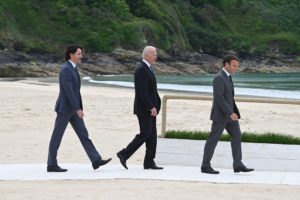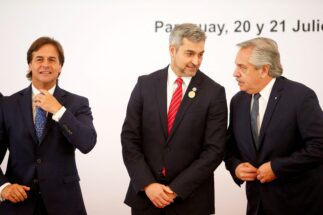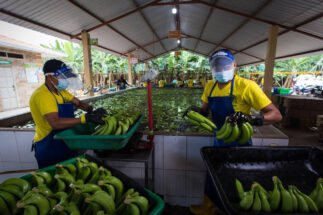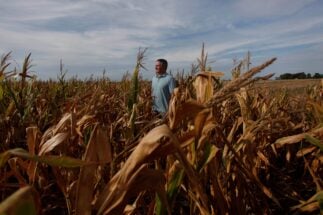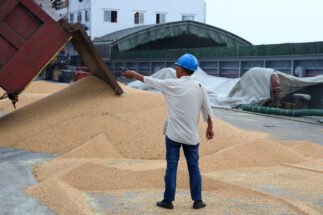In April 2019, Panamanian trade representatives met their Chinese counterparts in Beijing for what was billed as the fifth and final round of negotiations towards a free trade agreement (FTA) between the two countries. Following a whirlwind diplomatic romance – which began when former president Juan Carlos Varela cut ties with Taipei in favour of Beijing in 2017, and culminated in Xi Jinping’s visit to Panama a year later – the trade deal was seen as an important milestone for Panama’s shifting economic and foreign policy.

Three months later, the deal appeared to be dead. A new president, Laurentino “Nito” Cortizo, paused talks and said that his government would revise the content of the negotiations, “in detail and with caution”. However, while in Los Angeles for this year’s Summit of the Americas, Cortizo told media that FTA talks with China were set to resume.
“We are going to restart this negotiation with China,” he told France 24. “This process has to realign more towards the agricultural sector from Panama’s point of view… Even though we’re a small country we have been able to negotiate [one-on-one] with major powers like the United States, and we’ll do the same with China.”
What provoked Cortizo’s sudden change of heart? Local experts and analysts believe the decision was motivated by frustration at the US’ own inflexible trade policy. After winning presidential elections in July 2019, Cortizo aligned his foreign policy back towards the US, a traditional ally. Chinese investment plans, including a US$4 billion high-speed railway, were put on ice and Chinese companies lost out on key infrastructure tenders. Meanwhile, in November 2021, the Panama Canal Authority signed a contract with the US Army Corps of Engineers for consulting and advisory services on a future $2 billion infrastructure project to ensure adequate water supply to the canal.
Even though we’re a small country we have been able to negotiate with major powers like the US, and we’ll do the same with China
But the limits of Washington’s goodwill became clear in March this year, when the US embassy’s chargé d’affaires in Panama (the ambassador’s post has been vacant since 2018) said it would not meet the nation’s demands to revise its FTA with the US.
The Panama–United States Trade Promotion Agreement, an FTA which entered into force in 2012, allowed the Central American country to maintain import tariffs on a number of agricultural products, including rice, dairy, chicken and beef, in order to protect local producers from cheaper American imports. As per the original deal, those tariffs are to be gradually phased out, starting this year, but local producers have not managed to improve their competitiveness. Panamanian officials have therefore made repeated calls over the last year to review the terms of the agreement.
In the same interview with France 24, Cortizo said the FTA was “extremely favourable” to the US. The timing of the announcement of the resumption of talks with China is likely to be a measure to pressure the US into compromise over the tariffs, according to Euclides Tapia, professor of international relations at the University of Panama.
“While the Panamanian government is making an absurd demand of the US, in parallel they announce, as a form of pressure, the reactivation of commercial negotiations with China,” he said. “I don’t think it’s a coincidence.”
Panama – China FTA: limits to negotiation tactic
Cortizo’s gambit is unlikely to succeed. Given the US’ formidable farming export industry and the vulnerability of Latin American smallholder farmers, agricultural tariffs have been the most politically sensitive issue in the US’ trade deals in the region and beyond. A renegotiation of terms would set a precedent and likely lead to similar requests from the US’ 19 other free trade partners.

“I don’t think the Cortizo government is reading the tea leaves effectively,” says Eric Farnsworth, vice president of the Council of the Americas, a US-based think tank. “I don’t think anyone in Washington has any interest in reopening the Panama FTA. To do so would mean Peru and Colombia lining up for the same, then Morocco and Jordan.”
The recently elected left-wing president of Colombia, Gustavo Petro, has frequently stated he would look to review the country’s existing trade deal with the US. Between its signature in 2012 and 2019, the value of US poultry exports to Colombia increased from $27 million to nearly $102 million, while corn exports increased from around $86 million to $685 million, according to US Department of Agriculture figures. Colombian campesinos, however, feel similarly unable to compete, with the FTA a point of contention and target of multiple protests in the past decade, including in 2021, in 2019, and a nationwide agrarian strike in August 2013.
Panama experienced similar protests in July 2022, this time motivated by rising living costs and widespread corruption. With an approval rating hovering around 21%, Cortizo, who hails from a cattle-ranching background, can ill afford to lose the support of farmers. But the apparently misguided use of trade policy to gain concessions shows the limits to which smaller Latin American nations can play the US and China against each other.
Varela’s courtship of China created significant diplomatic blowback. “From a US perspective, Varela went too far, too fast,” said Farnsworth. “He got a lot of negative attention, a lot of pushback in Washington.”
In 2018, during the Varela administration, it was reported that former US diplomats had admitted pressuring the Panamanian government not to permit the construction of a Chinese embassy at the entrance of the Panama Canal. But it is unclear what further incentives or pressures the US government brought to bear on Cortizo to convince him to cool the relationship with China.
I don’t think anyone in Washington has any interest in reopening the Panama FTA. To do so would mean Peru and Colombia lining up for the same
The US has sought to push back against Chinese investment and involvement elsewhere in the region. In Chile, for example, it emerged that US diplomats had threatened to remove the country’s US visa waiver program should they allow Chinese telecom firm Huawei to construct a proposed trans-Pacific cable project.
It remains to be seen for how much longer such pressure will be enough from a US perspective. In recent years, China has become the largest trading partner of Brazil, Chile, Peru and Uruguay, and the latter recently ignored the protests of its Mercosur partners to initiate FTA talks with China. A Chinese trade agreement in Panama, one of the US’ most staunch allies in the region and a geopolitically strategic node as a result of its Canal, would be a symbolic milestone.
It would also highlight the lack of a clear US trade agenda in the hemisphere, according to Farnsworth. He believes Panama should instead look to incorporate itself into the United States-Mexico-Canada Agreement (USMCA).
“Panama would be a terrific partner, and its services-based economy could really benefit,” he said. “I think they’re shooting the wrong target. You know, instead of looking at the past, let’s look in the future. Let’s figure out a way to link Panama more meaningfully into the North American economy.”
Panama’s Ministry of Trade and the US Embassy in Panama did not respond to requests for comment.

